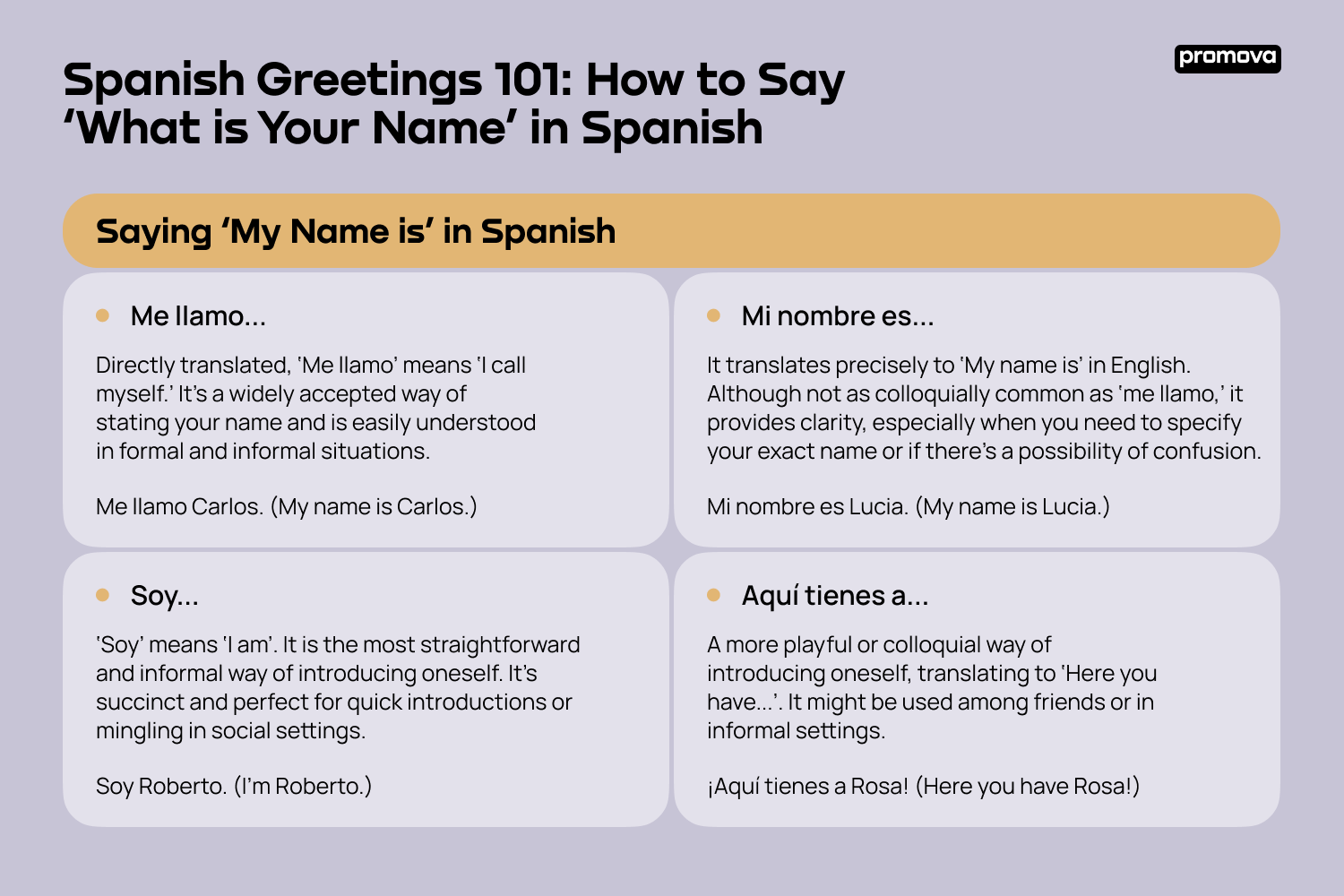Spanish Greetings 101: How to Say ‘What is Your Name’ in Spanish

Contents
Spanish language interactions often begin with introductions. From saying ‘What is your name?’ in Spanish to knowing how to respond appropriately, the ability to introduce yourself sets the foundation for any conversation. This guide will delve into the most common ways to inquire about names, ensuring you’re well-prepared to engage in genuine interactions. This foundation will not only aid in introductions but also in fostering lasting connections.
How to Say ‘What is Your Name’ in Spanish: ¿Cómo te llamas? And Other Variants
Inquiring about someone’s name is often the opening of any conversation, and understanding how to ask ‘What is your name?’ correctly will bridge linguistic gaps from the get-go. Below, we explore different ways to ask this ubiquitous question.
- ¿Cómo te llamas?
‘¿Cómo te llamas?’ is a staple. It’s versatile, fitting for both casual and more official settings. However, when speaking to someone older or in a formal situation, ‘¿Cómo se llama?’ is the more respectful choice.
Soy Elena, ¿tú cómo te llamas? (I’m Elena, what’s your name?)
Señor, ¿cómo se llama? (Sir, what’s your name?)
- ¿Cuál es tu nombre?
It is a more direct translation of ‘What’s your name?’ in Spanish. While less commonly used in everyday life, ‘¿Cuál es tu nombre?’ might be heard during official procedures or form fillings.
Disculpe, ¿cuál es tu nombre? (Excuse me, what’s your name?)
Señorita, ¿cuál es su nombre completo? (Miss, what’s your full name?)
- ¿Cuál es tu apellido?
It is specifically asking for one’s surname. In Spanish-speaking cultures, people often have two last names (maternal and paternal), so this question might prompt an answer that includes both.
Mi apellido es Gonzalez. (My last name is Gonzalez.)
¿Y tu apellido? (And your last name?)
- ¿Cómo te puedo llamar?
Translating to ‘What can I call you?’ it is a more informal Spanish phrase for ‘What is your name?’. It generally implies a more casual conversation or setting.
¿Cómo te puedo llamar? Me gusta usar apodos. (What can I call you? I like using nicknames.)
- ¿Puede decirme su nombre, por favor?
It is a polite way of asking for someone’s name. The emphasis on ‘please’ makes it particularly courteous.
¿Puede decirme su nombre, por favor? Es para el registro. (Can you tell me your name, please? It’s for the register.)
While serving the same primary function of getting to know someone’s name, these Spanish ‘What is your name’ phrases provide different nuances to the conversation. Depending on the context, the relationship between speakers, or the formality required, choosing the appropriate question can make your interactions smoother and more authentic.
Saying ‘My Name is’ in Spanish
Introducing oneself is a crucial step in initiating interactions in any environment. Stating one’s name can differ based on the context and the relationship between the speakers. Here are the phrases for saying ‘It is my name’ in Spanish:
- Me llamo...
Directly translated, ‘Me llamo’ means ‘I call myself.’ It’s a widely accepted way of stating your name and is easily understood in formal and informal situations.
Me llamo Carlos. (My name is Carlos.)
Hola, me llamo Maria. (Hello, my name is Maria.)
- Mi nombre es...
It translates precisely to ‘My name is’ in English. Although not as colloquially common as ‘me llamo,’ it provides clarity, especially when you need to specify your exact name or if there’s a possibility of confusion.
Mi nombre es Lucia. (My name is Lucia.)
Buenas tardes, mi nombre es Alejandro. (Good afternoon, my name is Alejandro.)
- Soy...
‘Soy’ means ‘I am’. It is the most straightforward and informal way of introducing oneself. It’s succinct and perfect for quick introductions or mingling in social settings.
Soy Roberto. (I’m Roberto.)
Hola, soy Paola. (Hello, I’m Paola.)
- Es un placer, soy...
It translates to ‘It’s a pleasure, I am...’ and is a polite way to introduce oneself, especially in formal situations or when meeting someone for the first time.
Es un placer, soy Gabriel. (It’s a pleasure, I am Gabriel.)
- Aquí tienes a...
A more playful or colloquial way of introducing oneself, translating to ‘Here you have...’. It might be used among friends or in informal settings.
¡Aquí tienes a Rosa! (Here you have Rosa!)
- Puedes llamarme...
It means ‘You can call me...’ and is used when one has a nickname or prefers to be addressed in a particular way.
Mi nombre es Francisco, pero puedes llamarme Paco. (My name is Francisco, but you can call me Paco.)
- Se me conoce como...
Translating to ‘I’m known as...’, this expression is a bit more formal and might be used when someone has a title or is known by a particular name in a professional setting.
Se me conoce como Doctor Ramírez en el hospital. (I’m known as Doctor Ramírez at the hospital.)
- A la orden, soy...
Common in some regions, it translates to ‘At your service, I am...’ It’s a polite and slightly formal way to introduce oneself.
A la orden, soy Marta. (At your service, I am Marta.)
Navigating these phrases for saying what your name is in Spanish might seem tricky initially, but with practice, one can easily discern which expression to use based on the situation. Using the correct phrase helps convey the message clearly and shows cultural sensitivity and awareness. As with many aspects of language learning, exposure and practice are essential. So the next time you find yourself in a Spanish-speaking setting, try these out and observe the responses to master the art of introduction.

Useful Phrases When Asking ‘What is Your Name’ in Spanish
When meeting someone new in a Spanish-speaking context, having a range of phrases at your disposal is beneficial to navigate the introduction smoothly. Here’s a list of handy expressions and their descriptions:
- ¿Me lo podrías repetir?
This phrase translates to ‘Could you repeat that?’ and is used when you don’t hear or understand what the other person said. It’s polite and indicates genuine interest.
Encantada de conocerte, señora. ¿Me podrías repetir tu nombre? (Nice to meet you, ma’am. Could you repeat your name?)
- ¿Cómo se escribe?
It means ‘How is it written?’ or ‘How do you spell that?’. It’s a respectful way of ensuring you understand and remember a person’s name correctly, especially if it’s unique or unfamiliar.
Me dijiste que te llamas Yael. ¿Cómo se escribe? (You told me your name is Yael. How do you spell that?)
- Tocayo
A ‘tocayo’ is someone who has the same name as you. This term is often used in casual settings among Spanish speakers and denotes a sense of camaraderie.
¡Hola, Diego! También soy Diego. ¡Somos tocayos! (Hello, Diego! I’m also Diego. We have the same name!)
- No capté tu nombre, ¿me lo dices de nuevo?
It means, ‘I didn’t catch your name, can you tell me again?’. If you missed it during the initial introduction, it’s a candid way to request someone’s name.
Estábamos hablando del proyecto y no capté tu nombre, ¿me lo dices de nuevo? (We were talking about the project, and I didn’t catch your name. Can you tell me again?)
Essential Vocabulary for Personal Introductions
A strong foundation of basic vocabulary can enhance the richness of your interactions. Here’s a list of essential terms to get you started:
- Nombre – Name.
- Apellido – Surname/Last name.
- Apodo – Nickname.
- Señor (Sr.) – Mister/Mr.
- Señora (Sra.) – Madam/Mrs.
- Señorita (Srta.) – Miss.
- Joven – Youngster/Youth.
- Amigo/Amiga – Friend (male/female).
- Compa ñero/Compañera – Mate/Colleague (male/female).
- Familia – Family.
- Hermano/Hermana – Brother/Sister.
- Padre/Madre – Father/Mother.
- Hijo/Hija – Son/Daughter.
- Esposo/Esposa – Husband/Wife.
Armed with these words, you can confidently answer what your name is in Spanish and introduce your family and friends effectively. Whether attending a social gathering, meeting new colleagues, or simply sparking a conversation with a stranger, this vocabulary is handy.
7
Promova: Your Gateway to the Spanish Language
Want to speak English, French, Italian, or talk the romantic Spanish lingo? Promova is your one-stop solution! We’re a language learning platform offering various features to master these languages.
With guided courses on our web and mobile apps, your language learning journey becomes a breeze. The emphasis is not just on vocabulary expansion but also on comprehension of complex grammar, idiom usage, and conversation skills.
Our mobile app is free to download, offering a user-friendly interface that iOS and Android owners can access anywhere, anytime. With engaging features such as vocabulary lists and quizzes, your learning experience becomes far more than acquiring new words – it becomes an adventure.
If you are learning English and desire a more personalized approach, you can opt for our one-on-one or group tutoring sessions. They offer targeted instruction tailored to your needs – making mastering English an exciting adventure rather than just another task. The first personal lesson is free so that you can experience the benefits for yourself!
Conclusion
Navigating Spanish introductions is key to unlocking genuine conversations and deeper connections. The language, rich in its variations, offers numerous ways to engage, each suiting different situations and dynamics. As you enter diverse Spanish-speaking environments with the right phrases and understanding, you’re poised to make lasting impressions and enrich your linguistic journey. Remember, in every ‘¿Cómo te llamas?’, there’s an opportunity for a new story and connection.
FAQ
Why is context crucial when choosing how to introduce oneself in Spanish?
Context helps determine the level of formality required. For example, in professional or formal situations, using ‘Mi nombre es...’ or ‘Es un placer, soy...’ might be more appropriate. Conversely, when you’re among friends or in a casual context, using phrases like ‘Soy...’ and ‘Aquí tienes a...’ might feel more natural.
Why is the verb ‘ser’ used for names and not ‘estar’?
‘Ser’ relates to permanent states or characteristics, making it apt for names. ‘Estar’ is more temporary, often relating to feelings or locations. The use of ‘ser’ in stating names reflects that a person’s name is a permanent identity rather than something transient or variable like mood or position.
How can I practice introduction phrases effectively?
Practicing introduction phrases effectively involves regular repetition, ideally in real-life situations. You can converse with native speakers, find a language exchange partner, or try role-play situations.
Which resources are useful for learning Spanish vocabulary?
For in-depth vocabulary learning, WordReference and Collins Spanish Dictionary are commendable digital platforms that offer a wealth of words and examples. Also, the Spanish language learning app by Promova provides vocabulary lists, flashcards, and quizzes to make your learning journey engaging.
Comments